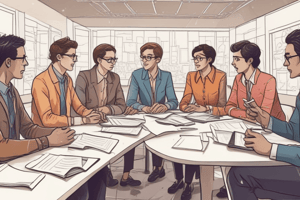Podcast
Questions and Answers
What is the initial component of the problem-solving process as described?
What is the initial component of the problem-solving process as described?
- Undesirable situation (correct)
- Decision-making
- Desired situation
- Obstacles
Which of the following is NOT identified as a common problem faced by groups?
Which of the following is NOT identified as a common problem faced by groups?
- Planning events
- Building consensus (correct)
- Budgeting funds
- Raising awareness about issues
In group problem-solving, which component requires the most work?
In group problem-solving, which component requires the most work?
- Evaluating results
- Identifying obstacles (correct)
- Generating solutions
- Establishing a desired situation
What can be considered an example of an obstacle in a group's problem-solving process?
What can be considered an example of an obstacle in a group's problem-solving process?
Which of the following statements accurately describes the desired situation?
Which of the following statements accurately describes the desired situation?
Which aspect of problem-solving is primarily focused on producing actionable solutions?
Which aspect of problem-solving is primarily focused on producing actionable solutions?
What type of resistance can be categorized as an obstacle in a group's problem-solving process?
What type of resistance can be categorized as an obstacle in a group's problem-solving process?
Which step is considered essential before generating solutions in group problem-solving?
Which step is considered essential before generating solutions in group problem-solving?
Which characteristic indicates that a group may need to engage in extensive background research?
Which characteristic indicates that a group may need to engage in extensive background research?
What is a likely consequence of having a high level of interest in a problem among group members?
What is a likely consequence of having a high level of interest in a problem among group members?
When tackling a problem with multiple possible solutions, what is a potential benefit for the group?
When tackling a problem with multiple possible solutions, what is a potential benefit for the group?
Which situation might indicate a problem is both difficult and complex?
Which situation might indicate a problem is both difficult and complex?
Why might a group with low interest prefer a specific type of leadership during problem-solving?
Why might a group with low interest prefer a specific type of leadership during problem-solving?
How does task difficulty affect group dynamics during problem-solving?
How does task difficulty affect group dynamics during problem-solving?
What often happens when groups face familiar problems compared to novel ones?
What often happens when groups face familiar problems compared to novel ones?
What does a limited number of solutions imply about a problem?
What does a limited number of solutions imply about a problem?
Which factor primarily enhances group participation and satisfaction?
Which factor primarily enhances group participation and satisfaction?
What type of messages contribute to building task dimensions within a group?
What type of messages contribute to building task dimensions within a group?
What aspect contributes significantly to member motivation within a group?
What aspect contributes significantly to member motivation within a group?
Which quality is essential for maintaining equity in group participation?
Which quality is essential for maintaining equity in group participation?
What is a primary reason for the adverse reaction to human relations training?
What is a primary reason for the adverse reaction to human relations training?
What does symbolic convergence refer to in group dynamics?
What does symbolic convergence refer to in group dynamics?
Why do some listeners react violently to perceived strategic behavior?
Why do some listeners react violently to perceived strategic behavior?
Which concept includes verbalized references to events outside the group’s immediate context?
Which concept includes verbalized references to events outside the group’s immediate context?
What is a key characteristic of clear and accepted roles in a group?
What is a key characteristic of clear and accepted roles in a group?
Which behavior is likely to reduce defensiveness during communication?
Which behavior is likely to reduce defensiveness during communication?
What is a major contributor to defensiveness in group settings?
What is a major contributor to defensiveness in group settings?
Which of the following behaviors is least likely to contribute to a positive group climate?
Which of the following behaviors is least likely to contribute to a positive group climate?
How can empathy in communication benefit interactions within training groups?
How can empathy in communication benefit interactions within training groups?
What happens to individual output as group size increases, according to studies on social loafing?
What happens to individual output as group size increases, according to studies on social loafing?
What impact does a lack of warmth in speech have on group members?
What impact does a lack of warmth in speech have on group members?
Which phenomenon explains the reduction in individual output in larger groups?
Which phenomenon explains the reduction in individual output in larger groups?
Which statement best represents the views on strategic behavior among group members?
Which statement best represents the views on strategic behavior among group members?
What is one psychological consequence individuals might face due to social loafing?
What is one psychological consequence individuals might face due to social loafing?
What is a common reaction to communication that appears detached and clinical?
What is a common reaction to communication that appears detached and clinical?
What could be a result of social loafing within a group setting?
What could be a result of social loafing within a group setting?
How did the experiment by Latane et al. (1979) rule out the theory of acoustics affecting individual output?
How did the experiment by Latane et al. (1979) rule out the theory of acoustics affecting individual output?
What aspect of group performance is primarily harmed by social loafing?
What aspect of group performance is primarily harmed by social loafing?
What might individuals miss out on due to the effects of social loafing in a group?
What might individuals miss out on due to the effects of social loafing in a group?
What is indicated by the term 'negative social cues' in the context of social loafing?
What is indicated by the term 'negative social cues' in the context of social loafing?
What should groups consider when determining the need for solution acceptance?
What should groups consider when determining the need for solution acceptance?
What consequence can occur if a group imposes a solution without stakeholder buy-in?
What consequence can occur if a group imposes a solution without stakeholder buy-in?
What is the first step in the group problem-solving process as mentioned?
What is the first step in the group problem-solving process as mentioned?
Which of the following does NOT represent a key component of problem definition?
Which of the following does NOT represent a key component of problem definition?
In what way can a systematic approach to problem-solving benefit a group?
In what way can a systematic approach to problem-solving benefit a group?
What should groups avoid to maintain positive group dynamics during problem-solving?
What should groups avoid to maintain positive group dynamics during problem-solving?
Which of the following describes how groups can confirm their planned solutions will be accepted?
Which of the following describes how groups can confirm their planned solutions will be accepted?
Which action should NOT be taken when defining a problem in a group setting?
Which action should NOT be taken when defining a problem in a group setting?
Flashcards
Group Cohesion
Group Cohesion
The degree to which members of a group are attracted to each other and motivated to stay in the group.
Positive Group Climate
Positive Group Climate
A positive and supportive group environment, impacting member satisfaction.
Group Morale
Group Morale
A measurement of the overall satisfaction and spirit of group members.
Participation
Participation
Signup and view all the flashcards
Symbolic Convergence
Symbolic Convergence
Signup and view all the flashcards
Group Fantasy
Group Fantasy
Signup and view all the flashcards
Feedback
Feedback
Signup and view all the flashcards
Equity in Participation
Equity in Participation
Signup and view all the flashcards
Adverse reactions to training
Adverse reactions to training
Signup and view all the flashcards
Spontaneous vs. strategic behavior
Spontaneous vs. strategic behavior
Signup and view all the flashcards
Deception and trust
Deception and trust
Signup and view all the flashcards
Genuine interest in people
Genuine interest in people
Signup and view all the flashcards
Neutral speech vs. empathy
Neutral speech vs. empathy
Signup and view all the flashcards
Importance of affect in communication
Importance of affect in communication
Signup and view all the flashcards
Valued and special
Valued and special
Signup and view all the flashcards
Role-flexible behavior
Role-flexible behavior
Signup and view all the flashcards
Solution Acceptance
Solution Acceptance
Signup and view all the flashcards
Task Difficulty
Task Difficulty
Signup and view all the flashcards
Number of Solutions
Number of Solutions
Signup and view all the flashcards
Stakeholders
Stakeholders
Signup and view all the flashcards
Group Member Interest
Group Member Interest
Signup and view all the flashcards
Problem Definition
Problem Definition
Signup and view all the flashcards
Group Familiarity
Group Familiarity
Signup and view all the flashcards
Problem Elements
Problem Elements
Signup and view all the flashcards
Solution Acceptance
Solution Acceptance
Signup and view all the flashcards
Group Problem-Solving
Group Problem-Solving
Signup and view all the flashcards
Pilot Implementation
Pilot Implementation
Signup and view all the flashcards
Complex Tasks
Complex Tasks
Signup and view all the flashcards
Buy-in
Buy-in
Signup and view all the flashcards
Creative Tasks
Creative Tasks
Signup and view all the flashcards
Limited Solutions
Limited Solutions
Signup and view all the flashcards
Deliberate Problem-Solving
Deliberate Problem-Solving
Signup and view all the flashcards
Problem-solving process
Problem-solving process
Signup and view all the flashcards
Common group problems
Common group problems
Signup and view all the flashcards
Problem components (3)
Problem components (3)
Signup and view all the flashcards
Obstacles in problem-solving
Obstacles in problem-solving
Signup and view all the flashcards
Undesirable situation
Undesirable situation
Signup and view all the flashcards
Desired situation
Desired situation
Signup and view all the flashcards
Obstacles (problem-solving)
Obstacles (problem-solving)
Signup and view all the flashcards
Social Loafing in Groups
Social Loafing in Groups
Signup and view all the flashcards
Ringlemann Effect
Ringlemann Effect
Signup and view all the flashcards
Latane's Study
Latane's Study
Signup and view all the flashcards
Decreased Group Output
Decreased Group Output
Signup and view all the flashcards
Effects of Social Loafing
Effects of Social Loafing
Signup and view all the flashcards
Individual Impact of Social Loafing
Individual Impact of Social Loafing
Signup and view all the flashcards
Social Loafing Business
Social Loafing Business
Signup and view all the flashcards
Social Loafing Education
Social Loafing Education
Signup and view all the flashcards
Study Notes
Group Cohesion and Climate
- Group cohesion refers to the commitment and attraction among group members, influencing the group climate, which is the enduring interaction tone experienced by members.
- Two types of cohesion exist: task and social.
- Task cohesion is the group's commitment to its purpose and activities, while social cohesion is the attraction and liking among members.
- Ideal groups balance these two types for optimal function, with task-oriented groups prioritizing task cohesion and relational-oriented groups prioritizing social cohesion.
- Cohesive groups exhibit several positive behaviors:easily set goals, show commitment to group purpose, are productive, have lower absenteeism, support each other during difficult times, and have satisfied members.
- Positive group climate, akin to group morale, is enhanced by participation, supportive messages, helpful feedback, equal opportunity for participation, and clear/accepted roles.
- Motivation increases when members feel connected to group goals and purpose.
- Symbolic convergence refers to group consciousness created through non-task communication (e.g., stories, jokes). Sharing group fantasies strengthens bonds.
Supportive and Defensive Group Climates
- Defensive communication arises when individuals perceive threat or anticipate threat. It is often associated with a focus on self-preservation over group success.
- Individuals engaging in defensive communication allocate energy to defending themselves rather than focusing on the group task.
- Defensive communicators exhibit behaviors like evaluation, control, strategy, and superiority, potentially escalating defensiveness within the group.
- In contrast, supportive communication techniques include description, problem-orientation, spontaneity, neutrality, empathy, and equality. These actions reduce defensive behaviors and promote effective communication.
- Jack Gibb's six pairs of defensive and supportive communication categories explain how different behaviors affect group climate.
Conflict
- Conflict is an expressed struggle between interdependent parties due to perceived incompatible goals or insufficient resources.
- Conflict must be expressed; if not, it isn't conflict.
- Conflict occurs among interdependent parties who need each other in order to accomplish something.
- Conflict arises from clashes over what people want or how to achieve those desires.
- Moderate conflict can be constructive, stimulating innovation and growth. It allows readjusting structures and reestablishing unity.
- Excessive or prolonged conflict is problematic as it leads to poor psychological well-being, and can negatively affect group cohesion and productivity.
Types of Conflict
- Substance conflicts (intrinsic conflicts) relate to differing factual interpretations or beliefs about what choices to make in a given situation.
- Value conflicts occur when disagreements arise from differing or prioritized values among group members.
- Process conflicts concern disagreements about how to reach a goal or pursue shared values.
- Misperceived differences arise from misinterpretations of others' actions or emotions.
The Conflict Process Model
- Thomas's model (frustration, conceptualization, behavior, outcome) explains the conflict process.
- Frustration occurs when a group or individual feels thwarted in pursuit of goals.
- Conceptualization is the problem-solving and strategy phase where conflicting parties understand the nature of the problem and potential solutions.
- Behavior involves the actual tactics used to resolve conflict, including competing, collaborating, compromising, avoiding, and accommodating.
- Outcome determines the extent to which conflict is resolved to the satisfaction of all parties involved.
Social Loafing
- Social loafing is the phenomenon of decreased individual effort when working in a group compared to working alone.
- Causes of social loafing include perceived inequitable contributions from others, submaximal goal setting, a perceived lack of connection between the member’s input and the outcome, lack of individual evaluation, and unequal compensation.
- Social loafing has negative consequences for groups, including reduced productivity, low cohesion, and dissatisfaction.
- It can also negatively impact individuals, leading to disappointment and decreased personal growth.
Group Decision-Making
- Group decision-making can be more creative and effective than individual decision-making due to collective experiences and perspectives.
- However, groups often experience process losses from coordination problems, social loafing, groupthink, and time constraints.
- Several decision-making methods include discussion ("plop"), delegation to an expert, averaging, voting, and consensus.
- Consensus involves reaching a decision through discussion and agreement from all parties. Though longer, it can lead to greater satisfaction and agreement by the team. It is distinct from unanimity.
Groupthink
- Groupthink is a phenomenon causing flawed decision-making through reduced reality testing, moral judgment, and mental efficiency, often due to group pressure to conform.
- Eight symptoms characterize groupthink: illusion of invulnerability, collective rationalizations, unquestioned belief in group morality, stereotyped views of out-groups, direct pressure, self-censorship, illusion of unanimity, and self-appointed mindguards.
- Large and cohesive groups are more prone to groupthink.
Problem-Solving Process
- Problem-solving involves a series of steps from initial issue definition to achieving a solution.
- Effective problem-solving requires defining the problem, analyzing it, generating solutions, evaluating those solutions, and implementing the final solution while assessing the effects.
- Five characteristics to consider include task difficulty, the number of possible solutions, interest and familiarity among group members, and the need for solution acceptance.
- Techniques like the "six thinking hats" method (White, Red, Black, Yellow, Green, and Blue hats) can aid creative problem-solving and decision-making within a group.
Leadership
- Leadership is a complex of beliefs and communication behaviors.
- Leaders can be designated (appointed) or emerge through the process.
- Trait approaches to leadership focus on distinguishing traits that set leaders apart from followers, such as communication ability, intelligence, and extroversion.
- Situational approaches consider how leadership effectiveness depends on the context and context determines the appropriate leadership approach.
- Functional approaches look at how effective leadership behaviors generate conditions for successful accomplishment through tasks, procedural processes, and interpersonal relations.
- Transformational leaders inspire followers to surpass expectations through idealized influence, inspirational motivation, individualized consideration, and intellectual stimulation.
Virtual Teams
- Successful virtual teams need to establish an online/virtual community and clear expectations.
- Five best practices for establishing a successful online community include clear expectations, effective organization, prompt and meaningful responses, a positive tone in communication, and regular review and reflection.
Studying That Suits You
Use AI to generate personalized quizzes and flashcards to suit your learning preferences.
Related Documents
Description
This quiz explores the concepts of group cohesion and climate, focusing on the dynamics that influence group interactions. It covers the two types of cohesion: task and social, and emphasizes the positive behaviors exhibited by cohesive groups. Understanding these concepts is essential for creating an optimal group environment.



